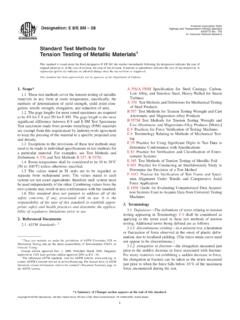Transcription of Polymerization Shrinkage Stress of Composites ...
1 Braz Dent J 20(4) 2009 Shrinkage Stress of composites319 INTRODUCTIONP olymerization is the chemical reaction that transforms small molecules into large polymer chains or networks. Monomer molecules are at intermolecular distances of 3-4 , but when they polymerize, the dis-tance between the so formed polymer units is only . This accounts for the Shrinkage during the polymeriza-tion process, typically of the order of (1). The magnitude of Polymerization Shrinkage is determined by the number of covalent bonds formed, that is, by the degree of conversion of the double carbon bonds of the monomers, as well as by the size of these molecules. Polymerization Shrinkage Stress of Composites Photoactivated by Different Light SourcesFernanda de Carvalho Panzeri PIRES-DE-SOUZA1 Brahim DRUBI FILHO1 Luciana Assirati CASEMIRO2 Lucas da Fonseca Roberti GARCIA3 Simonides CONSANI31 Department of Dental Materials and Prosthodontics, Ribeir o Preto Dental School, University of S o Paulo, Ribeir o Preto, SP, Brazil2 Dental School, University of Franca, Franca, SP, Brazil3 Department of Restorative Dentistry, Dental Materials Area, Piracicaba Dental School, State University of Campinas, Piracicaba, SP, BrazilThe purpose of this study was to compare the Polymerization Shrinkage Stress of composite resins (microfilled, microhybrid and hybrid) photoactivated by quartz-tungsten halogen light (QTH) and light-emitting diode (LED).
2 Glass rods ( mm x cm) were fabricated and had one of the surfaces air-abraded with aluminum oxide and coated with a layer of an adhesive system, which was photoactivated with the QTH unit. The glass rods were vertically assembled, in pairs, to a universal testing machine and the Composites were applied to the lower rod. The upper rod was placed closer, at 2 mm, and an extensometer was attached to the rods. The 20 Composites were polymerized by either QTH (n=10) or LED (n=10) curing units. Polymerization was carried out using 2 devices positioned in opposite sides, which were simultaneously activated for 40 s. Shrinkage Stress was analyzed twice: shortly after Polymerization (t40s) and 10 min later (t10min). Data were analyzed statistically by 2-way ANOVA and Tukey s test (a=5%). The Shrinkage Stress for all Composites was higher at t10min than at t40s, regardless of the activation source.
3 Microfilled composite resins showed lower Shrinkage Stress values compared to the other composite resins. For the hybrid and microhybrid composite resins, the light source had no influence on the Shrinkage Stress , except for microfilled composite at t10min. It may be concluded that the composition of composite resins is the factor with the strongest influence on Shrinkage Words: composite, photoactivation, Shrinkage Stress , halogen light, larger the molecules, for a same material volume, the smaller the number of bonds established and, thus, the smaller the Polymerization Shrinkage (2). In the field of dental Composites , different light- curing units (LCU), such as the quartz-tungsten halogen (QTH) lamps and light-emitting diodes (LED), can be used for photoactivation. LCU efficiency depends on the total energy concept. This concept explains that both intensity and photo-initiation time are important for efficient composite Polymerization .
4 When adequate curing with short curing time is desired, a higher in-tensity is required. Higher intensity also means higher Polymerization Shrinkage Stress at the tooth-restoration Correspondence: Profa. Dra. Fernanda de Carvalho Panzeri Pires-de-Souza, Departamento de Materiais Dent rios e Pr tese, Faculdade de Odonto-logia de Ribeir o Preto, USP, Avenida do Caf , S/N, 14040-904 Ribeir o Preto, SP, Brasil. Tel: +55-16-3602 3973. Fax: +55-16-3633-0999. e-mail: 0103-6440 Braz Dent J (2009) 20(4): 319-324 Braz Dent J 20(4) 2009 Pires-de-Souza et , as well as microleakage (3,4).There are difficulties associated with QTH units, such as expected life span of less than 100 h and the need for using filters due to high heat generation within the quartz bulb (5). The LED-structured Polymerization technique has appeared as an alternative to overcome or minimize these shortcomings.
5 LEDs have several advantages over QTH units, namely less heat produc-tion, continuous light production even over time, narrow wavelength (470 nm) and complete light beam absorp-tion by camphoroquinone, which is the most common photoinitiator in composite resins (6). New high-power LED devices have recently been developed, and this new technology offers irradiation similar to QTH lamps, with a view to provide higher quality Polymerization , and ac-tivation of photoinitiators others than camphoroquinone, since some Composites have different photoinitiators in their compositions, such as PPD (phenyl propadione) and BAPO (bis-acryl-phosphinoxide) (7).Factors others than light intensity inherent to the restorative technique are directly related to the polymer-ization Shrinkage in addition to. Factors like light curing modulation, increment size, C-factor, base material, and Polymerization kinetics are included (8).
6 As far as the material is concerned, the type and percentage of monomer and filler may determine the degree of cure, the time needed for Polymerization , the quality of the polymer links, the Shrinkage resulting from the process (9), and the shade and opacity of the composite resin (10).This study evaluated the Polymerization Shrinkage Stress of 3 types of composite resin polymerized by QTH and LED light-curing units. The tested null hypothesis was that composite Shrinkage Stress is not influenced by either the type of resin composite or the light AND METHODST hree composite resins and one adhesive system were used in this study, as shown in Table rods ( mm in diameter x cm in height) were fabricated and one of the flat ends was subjected to air abrasion with aluminum oxide to provide the surface roughness necessary for further retention of a composite resin increment.
7 Scotchbond Multipurpose adhesive system was applied on the air-abraded flat end and was photoactivated with a QTH light-curing unit for the time recommended by the manufacturer. In order to obtain each specimen, 2 glass rods were assembled to a universal testing machine (EMIC DL-2000; S o Jos dos Pinhais, PR, Brazil) in a vertical position using tensile test claws (Fig. 1A). The distance between the upper and lower rods was standardized in 2 mm. A composite resin increment was placed on the flat end of the lower rod using a hand instrument (Fig. 1B) until filling the 2-mm-high space between the rods. The relationship between bonded and non-bonded faces, corresponding to Factor C, was An extensometer was attached to the glass rods Table 1. Materials size ( m)Volume (%) HeliomolarMicrofilled compositeBis-GMA, - 0 .2046%Ivoclar/Vivadent, Schaan, LiechtensteinEsthet-XMicrohybrid compositeBis-GMA, Bis-EMA, - Caulk, Milford, DE, USAC harismaHybrid compositeBis-GMA, - Kulzer, Hanau, GermanyScotchbond MultipurposeAdhesive system ---3M/ESPE, St.
8 Paul, MN, USABis-GMA, bisphenol A diglycidyl ether dimethacrylate; Bis-EMA, Ethoxylated bisphenol A dimethacrylate, TEGDMA, Triethylene glycol dimethacrylate; UDMA, urethane Dent J 20(4) 2009 Shrinkage Stress of composites321in order to measure the Shrinkage Stress (kgf). The composite resin was photoactivated with 2 light-curing units positioned in opposite sides, perpendicular to the glass rods, at a distance of 5 mm from the composite resin surface, and simultaneously activated for 40 s (Fig. 1C). Twenty specimens were obtained for each composite resin - 10 were photoactivated with the QTH lamp (Ultralux; Dabi Atlante, Ribeir o Preto, SP, Brazil - power density: 480 mW/cm2) and 10 with LED unit (Ultraled; Dabi Atlante - power density: 500 mW/cm2). The intensity of light emit-ted was evaluated with a curing radiometer (Demetron Research Corp.)
9 , Danbury, CT, USA) before specimen photoactivation, also at the distance of 5 after Polymerization , the Shrinkage Stress (kgf) was recorded and considered as the Shrinkage at t40s. The Shrinkage Stress (kgf) was recorded again after 10 min (t10min). Along with the Shrinkage , there was also an approxima-tion of the glass rods and the extensometer recorded the resulting strain (kgf).Based on Shrinkage Stress values obtained at t40s and t10min, for each compos-ite resin polymerized with QTH and LED, the Stress ( = F/area) was calculated in MPa. Data were analyzed statistically by 2-way ANOVA and Tukey s test at a 5% significance 2 compares the Shrinkage Stress mean val-ues and standard deviations recorded at 40 s and 10 min for each material polymerized with the light-curing all composite resins, Shrinkage Stress was Figure 1. Specimen fabrication.
10 A = glass rods in the testing machine in a vertical position; B = Placement of a composite resin increment on the flat end of the lower rod; C = Simultaneous photoactivation of the composite resin 2. Shrinkage Stress mean values and standard deviations at 40 s and 10 unitComposite resin Mean Shrinkage Stress (SD) ( ) ( ) ( ) ( ) ( ) ( ) ( ) ( ) ( ) ( ) ( ) ( ) bDifferent letters in rows (t40s x t10min) indicate statistically significant differences (ANOVA and Tukey s test; p< ).Braz Dent J 20(4) 2009 Pires-de-Souza et at t10min, compared to t40s, independent of the polymerizing source, with statistically significant val-ues for each type of composite. Shrinkage Stress values were significantly lower (p< ) for the microfilled composite resin, followed by microhybrid and hybrid resins. The latter presented Stress values for t40s similar to those obtained for the microfilled composite at t10min, and microhybrid composite at t40s and t10min (p> ).














